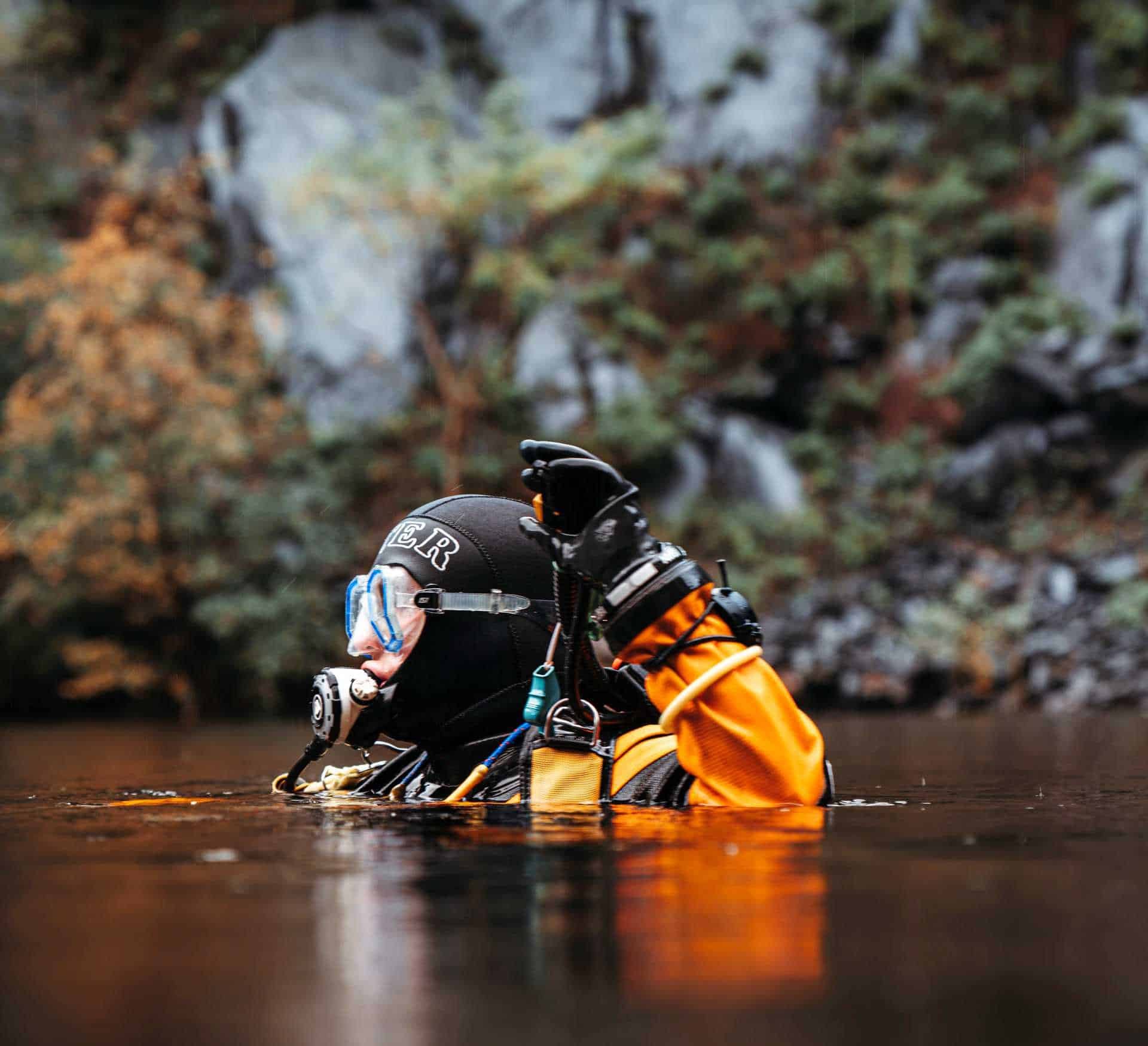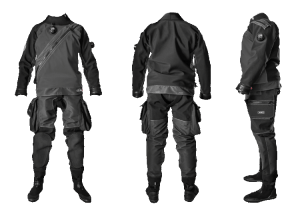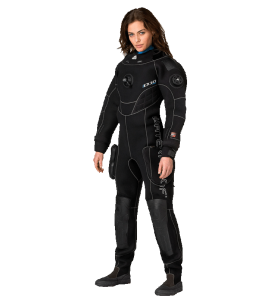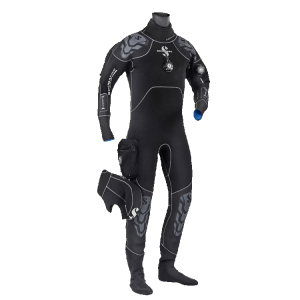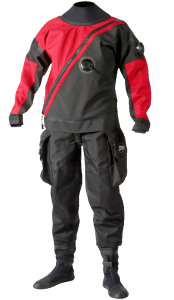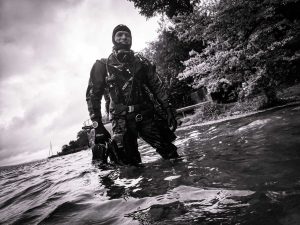Drysuits keep you dry, warm, and happy underwater. Once you start diving in cold water or caves or participate in long decompression dives, it might be time to upgrade your wetsuit to a drysuit.
However, a drysuit is a serious investment in your diving hobby so it’s important to find one that fits nicely and is suitable for the kind of diving you’re planning to do.
On this page, you can find the best scuba diving drysuits to buy in 2025 that we have tested.
After the list of drysuits, you can find a detailed scuba diving drysuits buyer’s guide with everything you need to know to pick the right one for you.
Best Scuba Diving Drysuits in 2025
These are the best scuba diving drysuits in 2025 for every budget and water temperature:
- Best trilaminate drysuit: Santi Elite Plus
- Best neoprene drysuit: Waterproof D10 Pro
- Best budget drysuit: ScubaPro Everdry 4.0
- Warmest drysuit: Ursuit One Endurance
- Best for advanced divers: Bare X-Mission Evolution
- Best tech-diving drysuit: Kallweit Xenon Front XFT-XTREME
We earn a commission if you make a purchase, at no additional cost to you.
Santi drysuits are the absolute creme de la creme of scuba diving drysuits and the Santi Elite Plus is one of the best trilaminate drysuits I’ve ever worn.
It’s just so well made, comfortable, and durable that there is really nothing wrong with it. The Santi suits are well-regarded in the industry and come with some super cool and well-thought-out features.
Last but not least, they look great and are easy to put on and off.
Specs & Features
| Type | Trilaminate Drysuit |
| Weight | 3.9kg (8.5 lbs) |
| Materials | Upper suit: Ripstop Nylon/Butylene/Ripstop Nylon 365-425g/sqm & Ripstop Nylon/Butylene/Polyester 515g/sqm Upper front and back bottom legs: Elastic, light fabric weighing 365-425g/sqm Back, elbows, lumbar area, lower front of the legs: E.Lite fabric, 515g/m2. |
| Available Colors | black / blue / gray / scarlet / arctic blue / turquoise / amber |
| Zipper type | TiZip Masterseal zip (plastic) |
| Zip location | Chest |
| Boot type | Flex soles / socks or socks + rock boots |
| Wrist seal | Latex or silicone |
| Glove type | Kubi glove system or Santi smart glove system |
| Neck seal | Latex or silicone |
| Hood included | Yes |
| Pockets | 2 |
| Valves | Apeks |
| P-Valve | Halcyon P-Valve |
| Custom sizing | Made to measure & custom sizing available |
| Other Features | telescopic torso, 3 tiers of lifetime warranty available |
We earn a commission if you make a purchase, at no additional cost to you.
The Waterproof D10 Pro ISS is the flagship drysuit model at Swedish scuba gear manufacturer Waterproof.
They are extremely well made and being from a cold country, all Waterproof drysuits feature excellent thermal insulation.
This is the successor to the popular D9 and previous D10 models and it comes with some nice quality improvements.
Specs & Features
| Type | Hi-Dense Neoprene Drysuit |
| Weight | 5.8kg (12 lbs) |
| Materials | Suit: 3.5mm Hi-Dense neoprene with SD Toughtex lining, Boots: DuPont™ Kevlar® Fiber reinforced |
| Available Colors | black / gray |
| Zipper type | plastic & metal zipper options |
| Zip location | Back |
| Boot type | Boot |
| Wrist seal | Latex |
| Glove type | – |
| Neck seal | Latex |
| Hood included | Yes, H1 5/7mm hood |
| Pockets | 2 |
| Valves | SI TECH |
| P-Valve | – |
| Custom sizing | – |
| Other Features | Warm neck system with molded velcro tabs, lifetime warranty available |
We earn a commission if you make a purchase, at no additional cost to you.
The ScubaPro Everdry 4.0 is a great budget drysuit for those who want the warmth and comfort of a drysuit but save at least $1,000-$2,000 in comparison to other big ones out there.
The suit is well made with just minor drawbacks over more mid-tier to premium suits and is a very warm suit.
There is also the ScubaPro Exodry which differs mainly in that the cuffs are of different materials and the cut is slightly altered.
Specs & Features
| Type | 4mm High Density Neoprene Drysuit |
| Weight | 4.12 kg (9.17 lbs) |
| Materials | Suit: High-Density Neoprene: Weighs 50% Less & is Significantly Softer than Traditional Neoprene |
| Available Colors | black |
| Zipper type | Plastic YKK Dry Suit Zipper, Covered by Neoprene Over Flap |
| Zip location | Back |
| Boot type | Neoprene Soft Socks |
| Wrist seal | Neoprene |
| Glove type | – |
| Neck seal | Neoprene |
| Hood included | Yes |
| Pockets | 1 |
| Valves | SI TECH |
| P-Valve | – |
| Custom sizing | – |
| Other Features | Lifetime warranty available |
We earn a commission if you make a purchase, at no additional cost to you.
I first tested the Ursuit drysuit offerings at the BOOT show in 2019 and was blown away by the quality and warmth of their suits
The Ursuit One Endurance is their flagship model and it comes with all the bells and whistles you would expect from it.
All the Ursuit drysuits are great, however, what really makes them stand out are their undergarments and thermofill underwear. Try it out, you have never been warmer on a dive, I can promise you that!
Specs & Features
| Type | Softdura Trilaminate Drysuit |
| Weight | 4.12 kg (9.17 lbs) |
| Materials | Suit: High-Density Neoprene: Weighs 50% Less & is Significantly Softer than Traditional Neoprene |
| Available Colors | black / grey / red / blue |
| Zipper type | Plastic or metal |
| Zip location | Front |
| Boot type | Neoprene Socks, Neoprene Boots, Dry Boots |
| Wrist seal | Latex, silicone, or neoprene |
| Glove type | – |
| Neck seal | Latex, silicone, or neoprene |
| Hood included | Yes, can be attached or separate |
| Pockets | 2, round |
| Valves | SI TECH or Apeks |
| P-Valve | Various options |
| Custom sizing | Made to measure available |
| Other Features | Neck ring, wrist ring available |
We earn a commission if you make a purchase, at no additional cost to you.
The Bare X-Mission Evolution is an absolute monster of a drysuit and arguably one of the best drysuits for recreational and technical divers ever made.
When you first put on the Bare X-Mission Evolution you feel like wearing a fancy tuxedo or tailored suit rather than a piece of diving equipment. It’s ultra-comfortable, looks like out of a James Bond movie, and is super flexible.
Bare is known for quality and even their lower-priced options are great. The Evolution is among the best drysuits ever made and a delight to dive.
Specs & Features
| Type | Nylon RipStop Trilaminate Drysuit |
| Weight | 3.4 kg (7.5 lbs) |
| Materials | Suit: Nylon RipStop Trilaminate 350 gr/sqm (main) & 420 gr/sqm (high abrasion areas: lower sleeves, butt, crotch) |
| Available Colors | black / red |
| Zipper type | Plastic |
| Zip location | Front |
| Boot type | Soft boot or vulcanized boot |
| Wrist seal | Latex, silicone, or neoprene |
| Glove type | – |
| Neck seal | 2MM nylon/smoothskin |
| Hood included | Yes |
| Pockets | 2 |
| Valves | Apeks |
| P-Valve | Various options |
| Custom sizing | Made to measure available |
| Other Features | Designed for cave diving |
We earn a commission if you make a purchase, at no additional cost to you.
The Kallweit Xenon Front XFT-XTREME is the drysuit I dive most often myself, whether I am by myself or with students.
It’s a powerpack of a trilaminate drysuit, looks super fancy, and is made for cave diving and other harsh environments.
I had mine custom-made like all Kallweit suits and it is the best drysuit I have personally ever worn (which is obviously why I use it so often). If you want to test the limits of diving, this is the suit to get.
Specs & Features
| Type | ContiTech Octolaminat® Drysuit |
| Weight | 3.4 kg (7.5 lbs) |
| Materials | Suit: ContiTech Octolaminat®, Cordura, Kevlar |
| Available Colors | black / grey / red |
| Zipper type | Plastic & metal available |
| Zip location | Front |
| Boot type | Socks and GTB Gatorboot |
| Wrist seal | Latex, silicone, or neoprene |
| Glove type | Dry gloves |
| Neck seal | Latex, silicone, or neoprene |
| Hood included | Yes |
| Pockets | 2 |
| Valves | Apeks |
| P-Valve | Various options |
| Custom sizing | Always custom made |
| Other Features | Kevlar reinforcement of the arm, buttocks, crotch, and knee areas |
What is a drysuit?
Drysuits are a type of exposure suit used by scuba divers to stay completely dry underwater and are much warmer than other types of suits. Drysuits seal off outside water with silicone, latex, or neoprene seals, dry zippers, and special valves and can be filled with air or argon to add more thermal insulation. Drysuits are often used in water temperatures below 15°C (60°F), as well as when diving for extended durations in technical and cave diving.
Frequent cold water diving is probably the most common reason why divers move on to buying a drysuit after using a wetsuit at first.
I like to call drysuits, especially membrane ones, “big, fancy underwater plastic bags” that keep you dry and help you float.
It is true that using a good drysuit can further improve your buoyancy and give you much better trim underwater.
Types of drysuits
There are three types of drysuits available:
- Crushed Neoprene Drysuits
- Membrane / Trilaminate Drysuits
- Proprietary Materials Drysuits
Crushed Neoprene
Crushed neoprene drysuits were the first type of drysuits available and are made of neoprene used in wetsuits…but highly crushed or compressed.
Such compression makes the suit thinner (imagine a 14mm neoprene suit without compression…), waterproof, and less buoyant.
The biggest benefits of crushed neoprene drysuits are that they provide thermal insulation and protection on their own, while being form-fitted and often relatively small in size.
Moreover, these types of drysuits are usually cheaper than other kinds.
Membrane / Trilaminate Drysuits
Membrane drysuits are often referred to as trilaminate drysuits (tri = three, laminate = layers) and are often the preferred choice by cave divers, technical divers, and dive instructors.
They are much thinner than neoprene drysuits and more flexible. However, they offer almost no thermal protection which is why we wear thick undergarments underneath to stay warm.
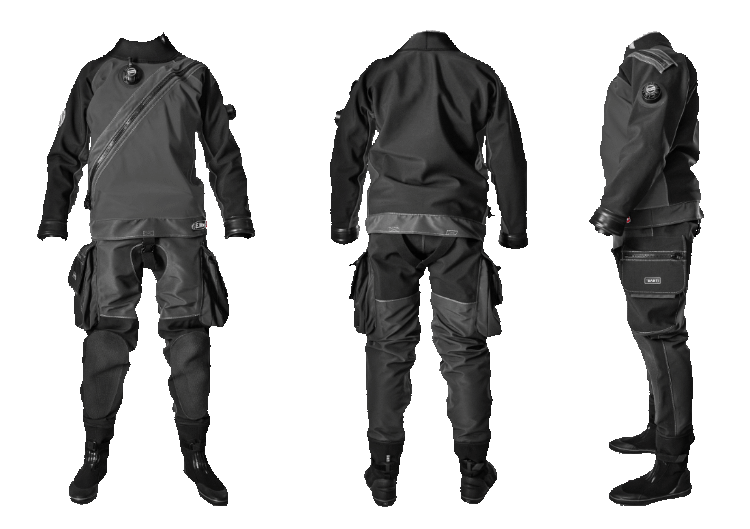
The biggest advantages of trilaminate drysuits are the flexibility to work in any water temperature and environment, lightweight, the strength of the material, and lower packing volume.
Additionally, they are highly customizable and easier to fix.
The downside to that is a much (!) higher price, the need to almost always wear extra undergarments, and higher maintenance effort.
Proprietary Materials Drysuits
When looking for a drysuit you might sometimes come across some extra materials manufacturers use to make their drysuits. They sometimes come with fancy names such as Octolaminate, Cordura, High-Density neoprene, etc.
In essence, while these materials surely have benefits and add extra strength and thermal protection, they are ultimately still types of crushed neoprene or membrane drysuits.
Buying a drysuit
Buying a drysuit can be a bit more complicated than buying a wetsuit, shorty, or rash guard since there are a lot more things to consider and keep in mind.
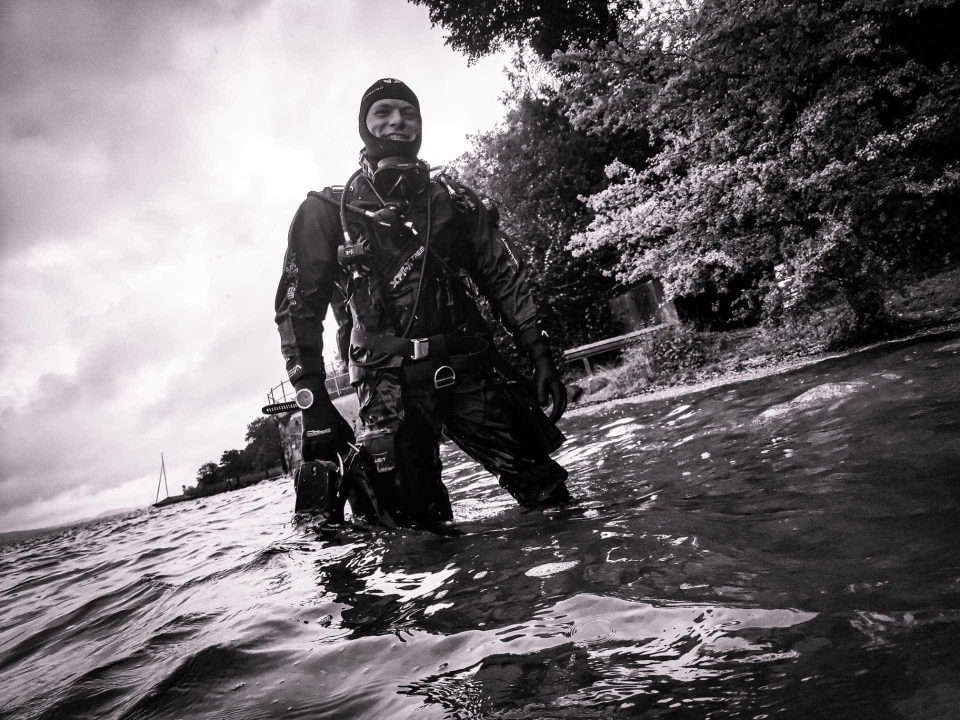
Set a budget for your drysuit
Let’s not deny it, drysuits are an expensive piece of diving equipment and they require quite an investment. Most drysuits are priced above $1,500 or even much higher, so be prepared to spend at least that.
Also, don’t forget that you will need dry boots, dry gloves, extra LP(low pressure) hoses, undergarments, extra weights, and other things to use your drysuit underwater.
Set a budget for yourself that you will stick to and then start looking in that price range.
As always give yourself a small(!) margin in case you find something a little above the initial budget that would be perfect for you.
Neoprene vs Membrane Drysuit
You read about the differences between neoprene and membrane or laminate drysuits above.
Now the question is: Which one to pick?
In my opinion, if you are on a very tight budget, but still need a drysuit for coldwater diving, get a budget crushed-neoprene drysuit which will save you a lot of money while still performing well.
The same goes if you only dive in one location or water temperature, and you know exactly that the drysuit you’re buying will be warm enough. It will be much easier to use the drysuit and not get hung up on undergarments or such.
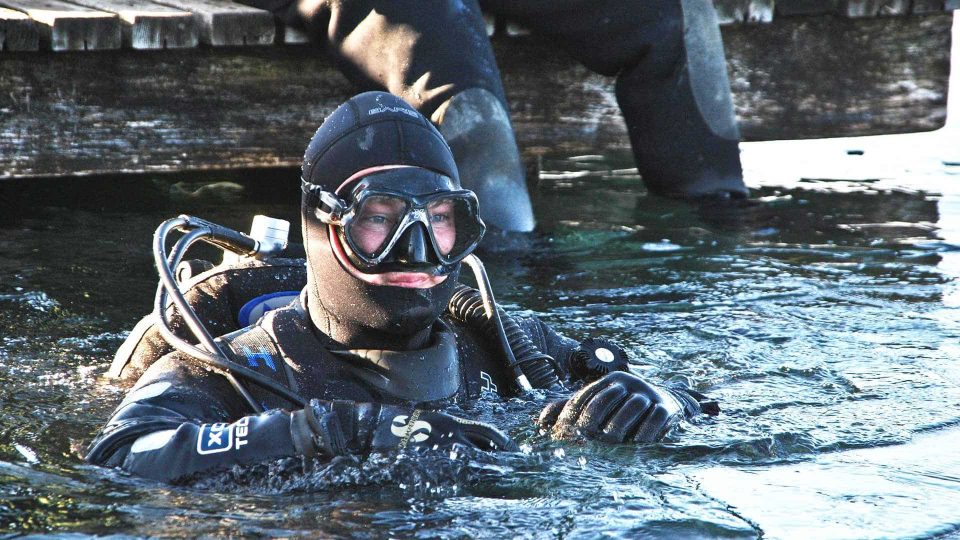
On the other hand, if you plan on diving in very different types of waters, visit different locations frequently or live at a place where the water temperature varies a lot throughout the year, I highly recommend a trilaminate or membrane drysuit.
They are much more flexible underwater, allow you to change the thermal layers inside to what is required, and are generally much more versatile in their usage.
If you are a technical or cave diver, I also highly suggest you go for a high-quality trilaminate drysuit as they offer much better buoyancy, extensibility, and maneuverability than neoprene ones.
Socks vs Boots
Unlike wetsuits, drysuits completely encapsulate the diver and do not let water in at the feet.
Most drysuits, therefore, come with socks or boots attached that are made of either neoprene, silicone, or latex.
Both have advantages and disadvantages so pick carefully.
Socks are usually made out of the same material as the rest of the drysuit and are thin, not super sturdy, and are meant to be used in combination with extra boots.
For this purpose, rock boots or dry boots are most common, which are essentially really thick diving boots. The biggest benefit of them is that they are replaceable (whereas a torn drysuit sock requires a complete suit repair) and extra warm.
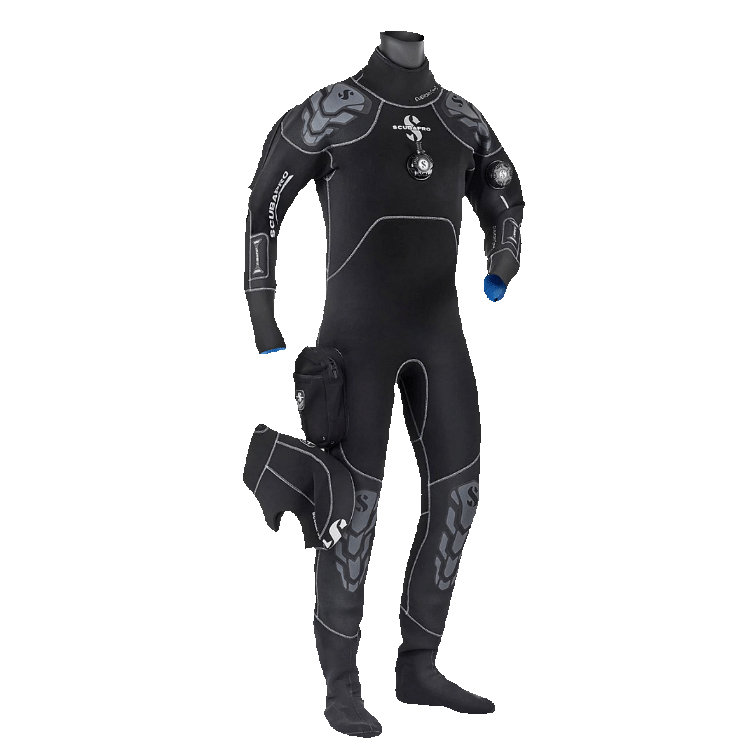
Some drysuits come with boots attached instead of socks. They are much sturdier and more durable than socks, however, not as much as external rock boots.
Drysuits with boots are often a little less expensive than buying drysuits with socks and extra boots. The disadvantage is that, similar to broken socks, they require a full suit repair once they break.
Front Zip vs Back Zip for drysuit?
Drysuits are equipped with a dry zip that’s either located on the front, called a front zip, or on the back of the suit, naturally referred to as a back zip. Similar to wetsuits, front zips are easier to open and close by yourself, whereas with a back zip, you need help from your dive buddy to close it. In return, they make the suit look more streamlined and aren’t in the way of any instruments.
I personally always go for front zips and it’s what the majority of drysuits use nowadays.
Being a dive instructor, I usually don’t get much help putting my scuba gear on and off and it’s much quicker to do it by myself.
Moreover, if there was ever an emergency and I needed to get out of the suit super quickly, a front zip has clear advantages.
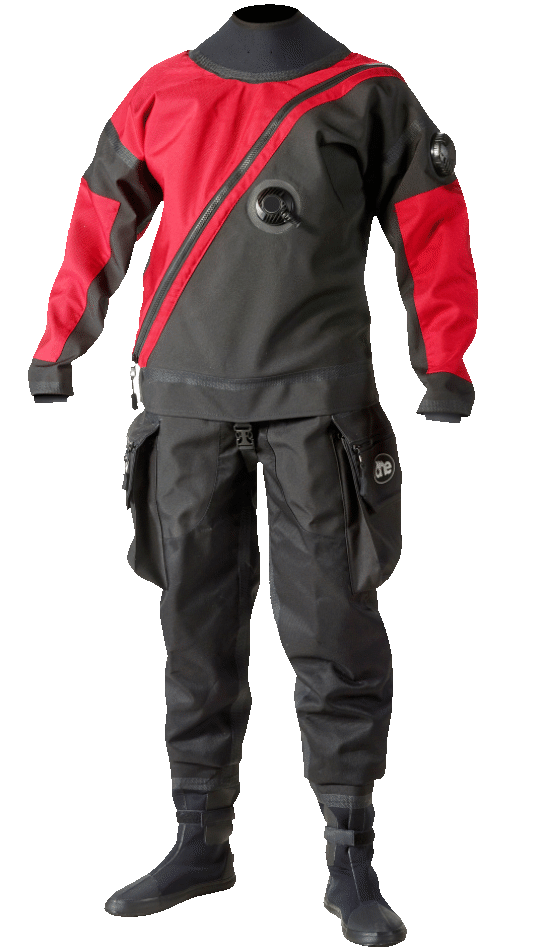
Metal or plastic zipper for a drysuit?
Drysuits come with either a metal or plastic dry zipper attached. Metal zippers are generally a little more sturdy than plastic zippers. However, they are less resistant to being, require more maintenance and care, and are heavier and less flexible. Most drysuit manufacturers recommend plastic zippers nowadays as they show clear advantages over older metal zipper configurations.
I personally always go with plastic zippers and haven’t ever regretted the decision.
They are just so much easier to handle and let’s be honest…if you’re ever in a situation where the plastic zipper breaks due to impact or sheer forces……you probably have to worry about many worse things than a zipper tooth breaking.
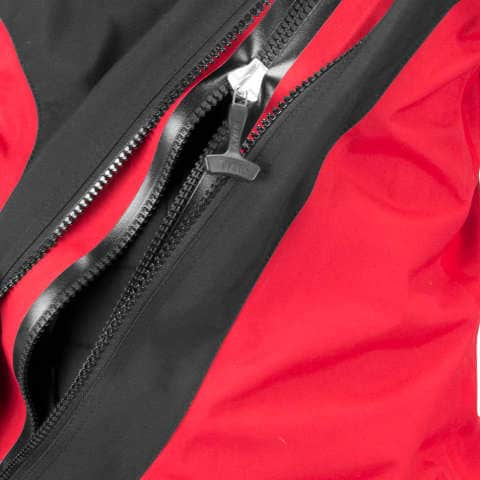
What Should I Wear Under A Drysuit?
What you wear under your drysuit depends on the water temperature, as well as the type of drysuit you’re using. For warm neoprene drysuits, thick skiing underwear is usually enough to stay warm. When using thinner membrane and trilaminate drysuits, divers wear special drysuit undergarments between 100mm – 700mm in thickness, thick skiing underwear, and socks to stay warm underwater. The colder the water temperature, and the longer the dive, the more thermal layers you need to wear under your drysuit.
As we already saw, crushed and high-density neoprene drysuits are much thicker than other types and offer plenty of thermal protection and insulation on their own.
Therefore, you usually get by with less underneath to stay warm, unless you dive in extremely cold water or under ice.
Long skiing underwear, a fleece jacket, thick socks, or double layers are recommended.
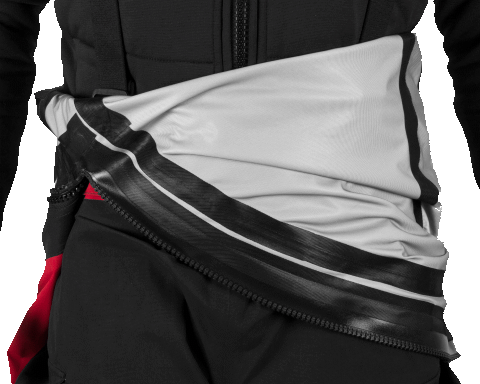
If you choose to buy a membrane or trilaminate drysuit which both offer more flexibility but are much thinner, you will need more thermal layers underneath.
In most cases, it is recommended to buy special drysuit undergarments between 100mm – 700mm in thickness as they are the perfect size for a drysuit and are usually extremely lightweight.
I usually wear skiing socks underneath as my feet tend to get rather cold quickly.
Should I buy a custom-fit Drysuit?
Similar to tailored suits, custom-fit or made-to-measure drysuits fit much better than those with standard sizes, are perfect for your specific body type and
